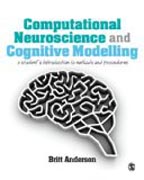
This unique, self-contained and accessible textbook provides an introduction to computational modelling neuroscience accessible to readers with little or no background in computing or mathematics. Organized into thematic sections, the book spans from modelling integrate and firing neurons to playing the game Rock, Paper, Scissors in ACT-R. This non-technical guide shows how basic knowledge and modern computers can be combined for interesting simulations, progressing from early exercises utilizing spreadsheets, to simple programs in Python. Key Features include: - Interleaved chapters that show how traditional computing constructs are simply disguised versions of the spreadsheet methods - Mathematical facts and notation needed to understand the modelling methods are presented at their most basic and are interleaved with biographical and historical notes for context - Numerous worked examples to demonstrate the themes and procedures of cognitive modelling. An excellent text for upper-level undergraduate and postgraduate students taking courses in research methods, computational neurosciencemputational modelling, and cognitive science/neuroscience. It will be especially valuable to psychology students. INDICE: Chapter 1: IntroductionPART 1: Modeling Neurons Chapter 2: What is a Differential Equation? Chapter 3: Numerical Application of a Differential Equation Chapter 4: Intermezzo: Computing With Loops Chapter 5: Integrate & Fire Chapter 6: Intermezzo: Computing With If Statements Chapter 7: Hodgkin & Huxley: The Men and Their Model Chapter 8: Intermezzo: Computing With Functions PART 2: Neural Networks Chapter 9: Neural Network Mathematics: Vectors and Matrices Chapter 10: Intermezzo: Interactive Computing Chapter 11: Neural Networks Chapter 12: Intermezzo: Interactive Exploration of the Delta Rule with OctaveChapter 13: Associative Memory and the Hopfield Net PART 3: Probability and Psychological ModelsChapter 14: What are the Odds? Chapter 15: Decisions as Random Walks Chapter 16: Intermezzo: Programming Psychophysical Experiments with Python PART 4: Cognitive Modeling as Logic and Rules Chapter 17: Boolean Logic Chapter 18: Intermezzo: Computing With Functional Languages Chapter 19: Production Rules and Cognition Chapter 20: Intermezzo: Functional Coding of a Simple Production System Chapter 21 ACT-R: A Cognitive Architecture Chapter 22: Agent Based Modeling Chapter 23: Concluding Remarks
- ISBN: 978-1-4462-4929-1
- Editorial: SAGE Publications Ltd
- Encuadernacion: Cartoné
- Páginas: 240
- Fecha Publicación: 06/01/2014
- Nº Volúmenes: 1
- Idioma:
